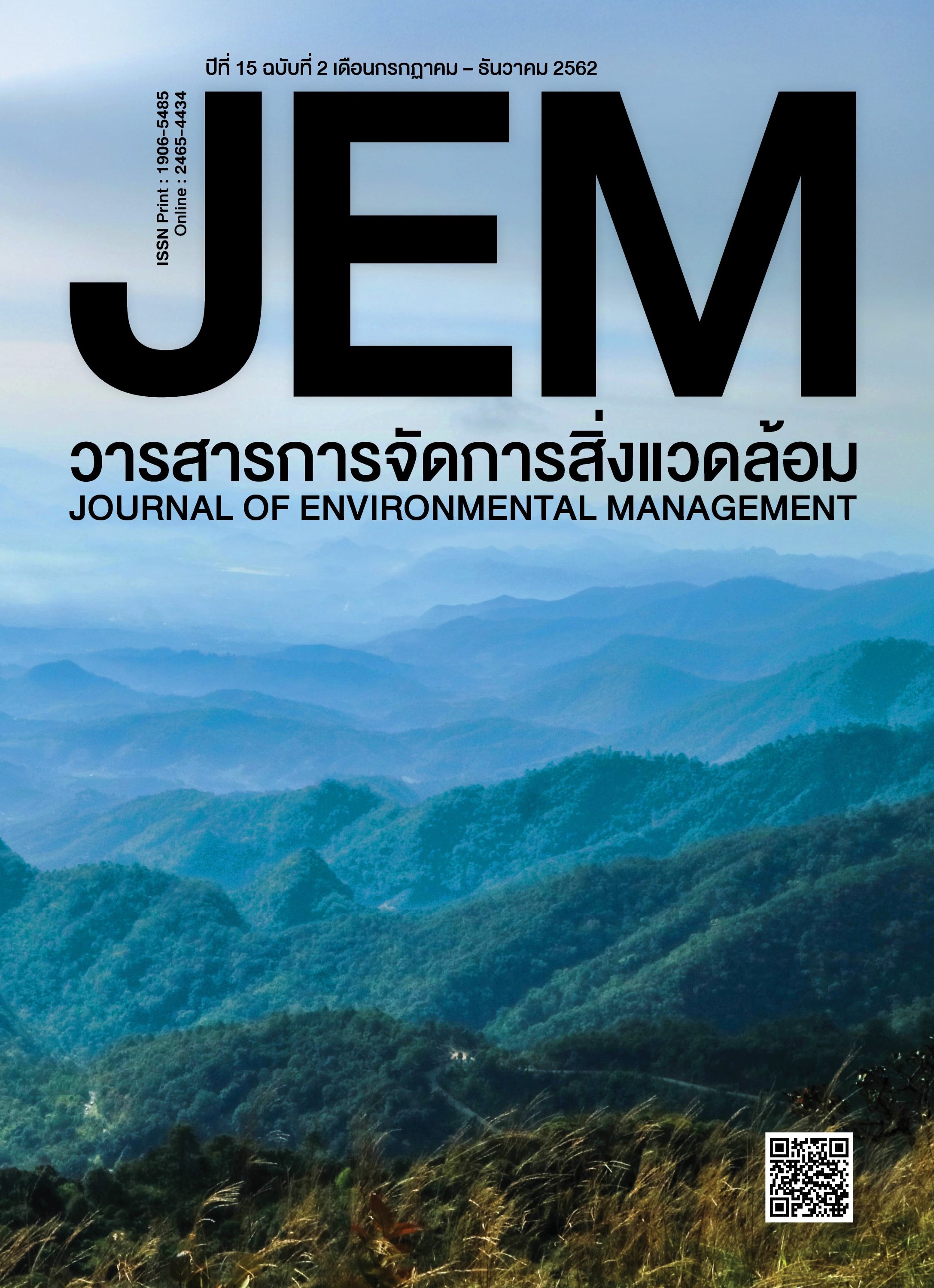ผลกระทบของการเปลี่ยนแปลง สภาพภูมิอากาศต่อปริมาณผลผลิตอ้อย ในพื้นที่ภาคตะวันออกเฉียงเหนือ THE EFFECT OF CLIMATE CHANGE ON SUGARCANE PRODUCTIVITY IN NORTHEASTERN THAILAND
DOI:
https://doi.org/10.14456/jem.2019.10คำสำคัญ:
ผลผลิตอ้อย, ภาคตะวันออกเฉียงเหนือ, ตัวแปรอุตุนิยมวิทยา, ปรากฏการณ์ ENSOบทคัดย่อ
การศึกษาผลกระทบของสภาพอากาศอันเนื่องมาจากปรากฏการณ์ ENSO ต่อปริมาณผลผลิตอ้อยในพื้นที่ภาคตะวันออกเฉียงเหนือ มีวัตถุประสงค์เพื่อศึกษาความสัมพันธ์ระหว่าง ปรากฏการณ์ ENSO และปริมาณน้ำฝน อุณหภูมิ อัตราการระเหยน้ำ ความชื้นสัมพัทธ์ และความเร็วลม และศึกษาผลกระทบจากปัจจัยอุตุนิยมวิทยาอันเนื่องมาจากปรากฏการณ์ ENSO ต่อปริมาณผลผลิตอ้อยในพื้นที่ภาคตะวันออกเฉียงเหนือ ซึ่งเป็นภูมิภาคที่ปลูกอ้อยมากที่สุดในประเทศไทย โดยวิธีการศึกษาใช้ข้อมูลทุติยภูมิ ได้แก่ ข้อมูลดัชนีการเกิดปรากฏการณ์ ENSO (Oceanic Nino Index) ข้อมูลอุตุนิยมวิทยา และข้อมูลผลผลิตอ้อยในพื้นที่ภาคตะวันออกเฉียงเหนือในช่วงระยะเวลา 20 ปี ตั้งแต่ปี พ.ศ. 2539 - 2558 ทำการวิเคราะห์โดยแบ่งช่วงข้อมูลตามฤดูกาล หาค่าเฉลี่ยรายฤดูกาลแล้ววิเคราะห์ความสัมพันธ์โดยใช้วิธีการวิเคราะห์สัมประสิทธิ์สหสัมพันธ์จากค่า R2 จากการศึกษาพบว่าดัชนี ONI มีความสัมพันธ์ตัวแปรอุตุนิยมวิทยา โดยที่ปริมาณน้ำฝนและความชื้นสัมพัทธ์มีความสัมพันธ์แบบแปรผันตรงกับดัชนี ONI ส่วนอัตราการระเหยน้ำและอุณหภูมิมีความสัมพันธ์แบบแปรผกผันกับดัชนี ONI และพบว่า ดัชนี ONI ไม่มีความสัมพันธ์โดยตรงกับปริมาณผลผลิตอ้อย แต่ผลผลิตอ้อยมีความสัมพันธ์กับตัวแปรทางอุตุนิยมวิทยา คือ ความชื้นสัมพัทธ์ และ อุณหภูมิ โดยปริมาณผลผลิตอ้อยมีแนวโน้มลดลงในปีเกิดปรากฏการณ์เอลนีโญ (El Niño :ONI ≥ 0.5) และตรงกันข้ามปริมาณผลผลิตอ้อยมีแนวโน้มเพิ่มขึ้นในปีที่เกิดปรากฏการณ์ลานีญา(La Niña :ONI ≤-0.5) โดยเฉพาะในโซนตะวันตกเฉียงใต้ของภูมิภาค (โซนที่4) ที่ค่าเฉลี่ยปริมาณผลผลิตในช่วงที่เกิดปรากฏการณ์ลานีญามีปริมาณมากกว่าในช่วงที่เกิดปรากฏการณ์เอลนีโญถึงร้อยละ 6 ซึ่งอ้อยได้รับผลกระทบจากความแปรปรวนของตัวแปรอุตุนิยมวิทยาในช่วงเดือนสิงหาคม ถึง เดือนตุลาคม เป็นหลักซึ่งเป็นช่วงที่อ้อยอยู่ในระยะย่างปล้องและมีผลโดยตรงต่อน้ำหนักผลผลิตอ้อยเมื่อเก็บเกี่ยว
เอกสารอ้างอิง
Amnat Chidthaisong. 2009. Thai climate change : Past climate, Volume 1. Bangko: The Thailand Research Fund . 198 p.
Atsamon Limsakul. 2011.Thailand's First Assessment Report on Climate Change 2011 Volume 1. Bangkok:Joint Graduate School of Energy and Environment King Mongkut’s University of TechnologyThonburi. (in Thai)
Division of Soil Surveying and Land Use Planning. 2015. Wonderful soil. Land Development Department. Ministry of
Agriculture and Cooperatives. Bangkok. (in Thai)
Glauco de Souza Rolim, Natália Buzinaro Caporusso, Victor Brunini Moreto and Angélica PrelaPantano. 2015. Influence
of El Niño and La Niña on sugarcane yield and sucrose production in northern São Paulo, Brazil. Astralian Journal
of Crop Sciene.9(6).509 - 516
Guillermo P. Podesta, Carlos D. Messina, Martin O. Grondona and Graciela O Magrin. 1998. Associations between
Grain Crop Yields in Central-Eastern Argentina and El Nin˜o–Southern Oscillation. Journal of Applied
Meteorology.38.1488-1498
Handler, P., 1984. Corn yields in the United States and SSTA in the equatorial Pacific Ocean during the period 1868–1982.
Agric. For. Meteor., 31, 25–32
Information Center Department of Agricultural Extension. 2013. Irrigation area year 2012. (Online). Available: https://www.agriinfo.doae.go.th/year56/general/irrigation/irr55.pdf (in Thai)
Kasem Suksathan. 1980. Sugarcane. In Thai Encyclopedia for youth 5th. Bangkok: Kurusapa Printing
Limsakul, Atsamon. 2015. The severity of climatic conditions and changes in Thailand. Green Research. 31. 15-22. (in Thai)
Marita G. Roberts, David Dawe, Walter P. Falcon and Rosamond L. Naylor. 2009. El Nino–Southern Oscillation Impacts on Rice Production in Luzon, the Philippines. Journal of applied meteorology and climatology.7.1718-1724
Marine Meteorological Center. 2561.wind. (Online). Available: https://www.marine.tmd.go.th/thai/windhtml/windhtml.html
Office of the Cane and Sugar Board. 2016. Report of sugarcane planting area, production year 2015/16. Bangkok. (in Thai)
Pam Knox, Melissa Griffin, Reshmi Sarkar and Brenda Ortiz. 2016. El Niño, La Niña and Climate Impacts on Agriculture:
Southeastern U.S.. Southeaster Climate.
Paulo Henrique Cirino, José Gustavo Féres, Marcelo José Braga and Eustáquio Reisd. 2015. Assessing the Impacts of ENSO-related Weather Effects on the Brazilian Agriculture. Procedia Economics and Finance. 24.146 – 155
Preecha Kapetch, Taksina Sansayawichai and Kobkiat Pisancharoen. 2013. The Effects of Environmental Variability on Sugarcane Production in the Northand the Northeast of Thailand. Thai Agricultural Research Journa. 32(1). (in Thai)
Preecha Kapetch. 2015. Soil moisture and sugarcane cultivation. Phi Bi J. Department of Agriculture
Somchai Boonpradub, Sukit Ratanasriwong, Vinai Sarawat, Precha Kapetch, Kathaliya Ek – un,Wibharat
Damrhikhemtrakul, Issara Buddhasimma, Krirk Pannangpetch.2009. Impact of Global Warming on Three Major
Field Crops Production of Thailand. KKU Res J. 14 (7):626-649. (in Thai)
Sutiluck Sikrai, Kanchalika Ratanacherdchai, and Sumran Pimratch. 2016. Comparison of sugarcane varieties for yield of planted sugarcane and appropriate agronomic practices after harvest on number of ratoons and growth of the first ratooning crop of Khon Kaen 3 and K95-84. J. Agricultural Phawarun. 13(2): 137-144. (in Thai)
Yokohama Symposium.1993. Impacts of extreme climatic conditions on sugar cane production in
northeastern Australia. IAHSPubr.n
ดาวน์โหลด
เผยแพร่แล้ว
เวอร์ชัน
- 2023-10-02 (2)
- 2019-12-23 (1)



